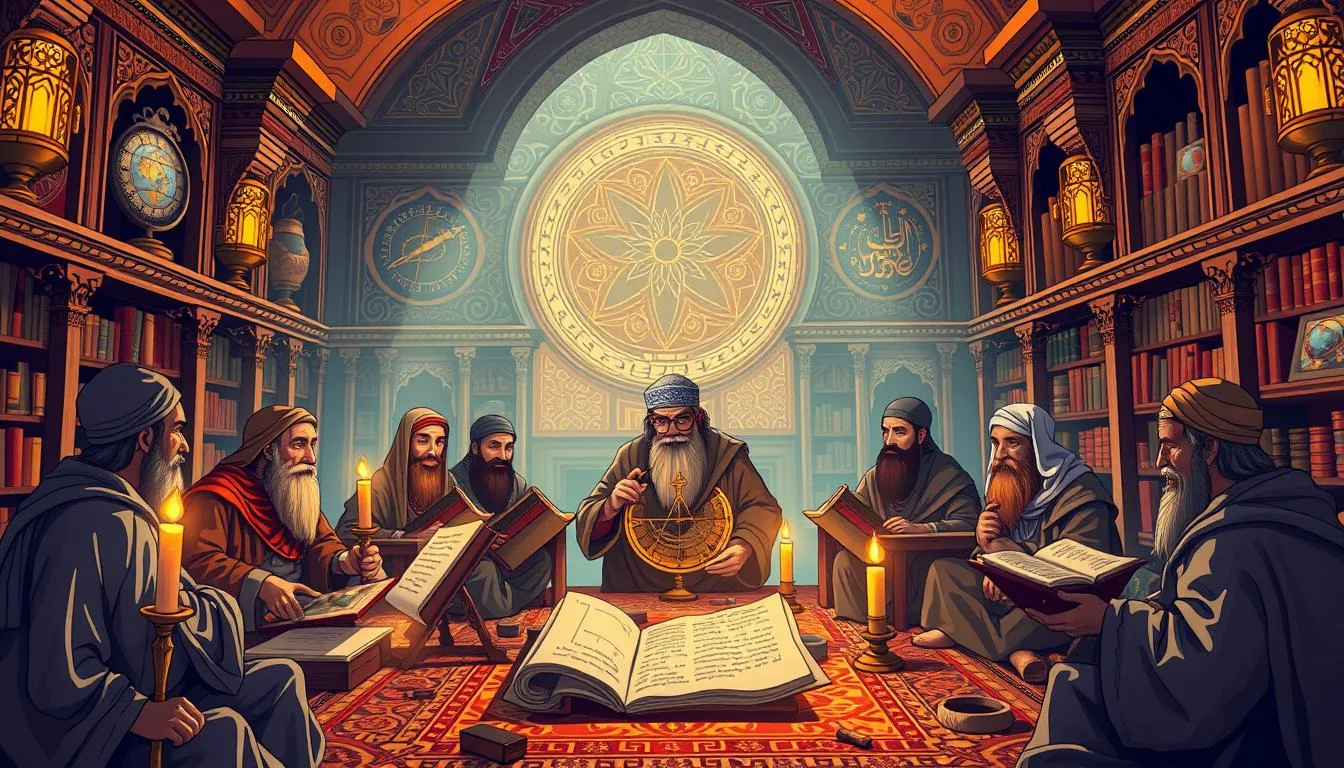
The Cultural and Scientific Impact of the Islamic Golden Age
The Islamic Golden Age, flourishing from roughly the 8th to the 13th centuries CE, represents a period of extraordinary intellectual and cultural ferment across the Islamic world. This era witnessed an unprecedented surge in scientific advancements, philosophical discourse, artistic expression, and architectural marvels, leaving an indelible mark on the trajectory of human civilization. Its influence extended far beyond its geographical boundaries, profoundly shaping the intellectual landscape of Europe and continuing to inspire awe and admiration centuries later. This exploration delves into the multifaceted contributions of this remarkable era, examining its origins, key figures, significant achievements, and lasting impact on the modern world.
I. The Genesis of an Intellectual Renaissance:
The Islamic Golden Age didn’t emerge spontaneously. It built upon the foundations laid by previous civilizations, particularly the Greco-Roman and Persian empires. The Abbasid Caliphate, which rose to power in 750 CE, played a crucial role in fostering this intellectual blossoming. Unlike its predecessor, the Umayyad Caliphate, which was primarily focused on military expansion and consolidation of power, the Abbasids actively promoted learning and scholarship. This shift in priorities was driven by several factors:
The Translation Movement: Recognizing the wealth of knowledge contained in ancient Greek, Persian, and Indian texts, the Abbasid caliphs initiated a massive translation project. The House of Wisdom (Bayt al-Hikma) in Baghdad became the epicenter of this endeavor. Scholars from diverse backgrounds – Christians, Jews, and Muslims – worked collaboratively, translating countless manuscripts into Arabic, making them accessible to a wider audience and facilitating cross-cultural intellectual exchange. This wasn’t merely a passive act of copying; it involved critical analysis, adaptation, and integration of these ideas into the existing Islamic intellectual framework.
Patronage of the Arts and Sciences: The Abbasid caliphs, particularly Al-Mansur, Al-Mahdi, and Harun al-Rashid, were generous patrons of the arts and sciences. They established libraries, observatories, and hospitals, attracting scholars and intellectuals from across the vast Islamic empire. This patronage created a fertile environment for intellectual inquiry, fostering competition and collaboration among scholars. The resulting intellectual ferment led to innovative breakthroughs across numerous fields.
Cosmopolitanism and Intellectual Exchange: Baghdad, as the capital of the Abbasid Caliphate, evolved into a vibrant cosmopolitan center. It became a melting pot of cultures, attracting scholars, traders, and travelers from diverse regions. This cross-cultural exchange fostered the synthesis of ideas, leading to new perspectives and innovations. The free flow of information and the absence of rigid intellectual boundaries allowed for a more dynamic and innovative intellectual environment.
Religious Tolerance (to a degree): While the Islamic empire was undeniably governed by Islamic law, the Abbasid period, compared to others, exhibited a degree of religious tolerance that facilitated intellectual collaboration. Scholars of different faiths were often employed in the House of Wisdom and other institutions, contributing to the overall intellectual growth. This tolerance, however, wasn’t absolute and varied across different regions and time periods.
II. Mathematical and Astronomical Marvels:
The Islamic Golden Age witnessed a flourishing of mathematics and astronomy, building upon and expanding upon the knowledge inherited from ancient civilizations. Key contributions include:
Algebra’s Genesis: Muhammad ibn Musa al-Khwarizmi, a Persian mathematician, is considered the father of algebra. His seminal work, Kitab al-mukhtasar fi hisab al-jabr wal-muqabala (The Compendious Book on Calculation by Completion and Balancing), introduced systematic methods for solving algebraic equations. The very word “algebra” derives from the Arabic term “al-jabr.” His work wasn’t simply a collection of formulas; it laid the foundations for a new branch of mathematics, significantly impacting the development of subsequent mathematical disciplines.
The Decimal System: Al-Khwarizmi’s work also played a crucial role in the dissemination of the Hindu-Arabic numeral system, including the concept of zero. This system, far superior to the cumbersome Roman numerals, greatly simplified mathematical calculations and paved the way for advancements in various scientific fields. Its adoption across the world represents a testament to its practical utility and elegance.
Advances in Trigonometry: Muslim mathematicians made substantial contributions to trigonometry, developing new techniques for solving trigonometric equations and producing accurate trigonometric tables. These advancements were crucial for astronomical calculations and navigation. The work of scholars like Abu al-Wafa’ and Nasir al-Din al-Tusi significantly advanced the field, providing refined methods and improved accuracy.
Astronomical Observations and Instruments: Muslim astronomers made precise observations of celestial bodies, developing sophisticated astronomical instruments like the astrolabe and the quadrant. They compiled extensive astronomical tables, refining existing models and developing new ones to better predict planetary positions and eclipses. Scholars like Al-Battani and Ibn Yunus made significant contributions to observational astronomy and the development of astronomical models. Their work corrected and extended the Ptolemaic model, paving the way for future astronomical advancements.
III. Revolutionizing Medicine and Healthcare:
The Islamic Golden Age witnessed a golden era in medicine, marked by both theoretical advancements and practical applications. The contributions were significant and far-reaching:
Ibn Sina (Avicenna) and the Canon of Medicine: Ibn Sina’s Canon of Medicine was a monumental achievement, serving as a standard medical textbook for centuries in both the East and West. It provided a comprehensive overview of medical knowledge, integrating Greek, Persian, and Islamic medical traditions. His contributions encompassed various aspects of medicine, including diagnosis, treatment, and pharmacology. His detailed descriptions of diseases, coupled with systematic approaches to treatment, significantly influenced medical practice for centuries.
Hospitals and Medical Education: The Islamic world saw the establishment of specialized hospitals (bimaristans), which served as centers of medical care, research, and teaching. These hospitals provided a structured environment for medical education, incorporating practical training alongside theoretical knowledge. They played a pivotal role in raising the standards of medical practice and fostering the advancement of medical knowledge.
Advancements in Surgery and Ophthalmology: Muslim surgeons developed innovative surgical techniques, including the use of anesthesia and advanced surgical instruments. They also made remarkable progress in ophthalmology, developing treatments for cataracts and other eye diseases. The meticulous surgical techniques employed during this period, along with advanced understanding of the human body, significantly reduced surgical risks and improved patient outcomes.
Pharmacology and the Development of New Drugs: Muslim physicians made significant contributions to pharmacology, developing new drugs and refining existing ones. They compiled comprehensive pharmacopoeias, documenting the properties and uses of various medicinal plants and minerals. Their systematic approach to the study of drugs laid the foundations for modern pharmacology.
IV. Philosophical and Theological Explorations:
The Islamic Golden Age wasn’t solely about scientific advancement; it encompassed profound philosophical and theological inquiries. Key contributions include:
The Neoplatonic and Aristotelian Influence: Muslim philosophers engaged extensively with the works of ancient Greek philosophers, particularly Plato and Aristotle. They integrated these ideas into Islamic thought, leading to creative synthesis and original philosophical contributions. This engagement resulted in the flourishing of Islamic philosophy, influencing both theological discourse and scientific methodology.
Ibn Sina (Avicenna)’s Philosophical Contributions: Beyond his medical achievements, Ibn Sina was a prolific philosopher who developed comprehensive systems of logic, metaphysics, and ethics. His work significantly impacted Western philosophy, particularly influencing the Scholastic thinkers of the medieval period. His contributions to logic, his innovative interpretations of Aristotelian concepts, and his explorations of metaphysics left a lasting legacy on philosophical thought.
Al-Ghazali and the Reconciliation of Faith and Reason: Al-Ghazali, a prominent theologian and philosopher, grappled with the relationship between faith and reason. He sought to reconcile the seemingly contradictory aspects of religious belief and rational inquiry. His work profoundly influenced Islamic theology and stimulated debates about the nature of knowledge and the limits of reason. His meticulous approach to understanding both faith and reason made a profound impact on Islamic thought.
The Rise of Sufism: Sufism, a mystical branch of Islam, flourished during the Islamic Golden Age. Sufi thinkers explored the inner dimensions of faith, emphasizing spiritual growth, self-purification, and the direct experience of the divine. Their contributions to poetry, literature, and music shaped the cultural landscape of the Islamic world. Sufi philosophy profoundly shaped Islamic culture and continues to influence spirituality to this day.
V. Architectural and Artistic Achievements:
The Islamic Golden Age was not limited to intellectual pursuits; it produced extraordinary architectural and artistic marvels:
Mosques and Palaces: The era witnessed the construction of magnificent mosques and palaces, showcasing sophisticated architectural designs and intricate ornamentation. The Great Mosque of Samarra and the Dome of the Rock stand as testaments to the artistic and engineering skills of the time. These buildings showcased advancements in engineering, mathematics, and art.
Calligraphy and Illumination: Islamic calligraphy achieved an unparalleled level of sophistication, becoming an art form in its own right. Intricate patterns and designs were used to illuminate manuscripts, showcasing a high level of skill and artistic expression. Calligraphy’s integral role in religious texts elevated its status beyond mere writing, transforming it into a respected and cherished art form.
Textiles and Ceramics: Islamic artists produced exquisite textiles and ceramics, displaying intricate patterns and vibrant colors. These artworks reveal a mastery of artistic techniques and a deep appreciation for aesthetics. The use of specific materials and color palettes contributed to the unique artistic character of Islamic art.
Music and Literature: The Islamic Golden Age nurtured the development of a rich musical tradition and produced a wealth of literary works, including poetry, prose, and philosophical treatises. These works often reflected the diverse cultural influences that shaped the Islamic world, showcasing a vibrant and multifaceted cultural landscape.
VI. The Enduring Legacy:
The impact of the Islamic Golden Age is immeasurable. Its contributions continue to resonate in the modern world:
The Foundation for Modern Science: Many scientific advancements that are foundational to modern science can be traced back to the Islamic Golden Age. The development of algebra, the refinement of trigonometry, and advancements in medicine and astronomy all played pivotal roles in the Scientific Revolution and the subsequent development of modern science.
The Transmission of Knowledge to Europe: The translation of Arabic texts into Latin during the medieval period facilitated the transmission of Islamic knowledge to Europe, influencing the intellectual and scientific development of the Renaissance and the Scientific Revolution. This transfer of knowledge was essential for the advancement of European science.
Cultural and Intellectual Influence: The artistic and literary achievements of the Islamic Golden Age continue to inspire artists and writers today. The aesthetic sensibilities and intellectual traditions of this era have had a lasting impact on world culture. This cultural influence can be observed in various artistic expressions and philosophical thought.
A Model for Intellectual Collaboration: The remarkable intellectual exchange and collaboration that characterized the Islamic Golden Age serve as a model for fostering intellectual cooperation and global understanding in the modern world. It stands as a testament to the power of collaboration and the positive impact it can have on scientific and cultural advancement.
The Islamic Golden Age remains a testament to the power of human ingenuity and the transformative potential of intellectual curiosity. Its achievements transcend geographical and temporal boundaries, offering valuable lessons and enduring inspiration for generations to come. It’s a reminder that periods of significant progress are often characterized by cross-cultural collaboration, intellectual tolerance, and a commitment to the pursuit of knowledge for its own sake. The echoes of this remarkable era continue to reverberate, shaping our world in ways we are only beginning to fully comprehend.


